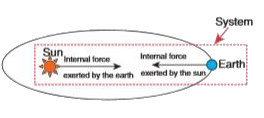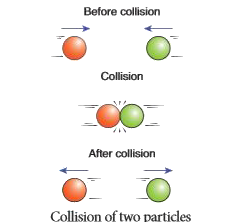Identify the internal and external forces acting on the following systems.
Earth and Sun as a system
Text Solution
(Earth + Sun) as a system In this case, there are two internal forces which form an action and reaction pairthe gravitational force exerted by the Sun on Earth and gravitational force exerted by the Earth on the Sun.

Meaning of law of conservation of momentum
1) The Law of conservation of linear momentum is a vector law. It implies that both the magnitude and direction of total linear momentum are constant. In some cases, this total momentum can also be zero.
2) To analyse the motion of a particle, we can either use Newton’s second law or the law of conservation of linear momentum. Newton’s second law requires us to specify.
the forces involved in the process.
This is difficult to specify in real situations. But conservation of linear momentum does not require any force involved in the process. It is covenient and hence important.
For example, when two particles collide, the forces exerted by these two particles on each other is difficult to specify. But it is easier to apply conservation of linear momentum during the collision process.

|
Topper's Solved these Questions
- LAWS OF MOTIONBOOK - NCERT TAMILCHAPTER - LAWS OF MOTIONEXERCISE - EXERCISE ( I. Multiple Choice Questions)
15 Videos
- LAWS OF MOTIONBOOK - NCERT TAMILCHAPTER - LAWS OF MOTIONEXERCISE - EXERCISE (V. Numerical Problems)
14 Videos
- LAW OF MOTIONBOOK - NCERT TAMILCHAPTER - LAW OF MOTIONEXERCISE - EXERCISE (ADDITIONAL EXERCISE)
17 Videos
- MECHANICAL PROPERTIES OF FLUIDS BOOK - NCERT TAMILCHAPTER - MECHANICAL PROPERTIES OF FLUIDS EXERCISE - EXERCISE
45 Videos
Similar Questions
Knowledge Check
If no external force acts on a system
A(a) velocity of centre of mass remains constantB(b) position of centre of mass remains constantC(c) acceleration of centre of mass remains non-zero and constantD(d) All of the aboveIf net external force acting on the system is zero then
AVelocity of the individual particle of the system will remain constantBVelocity of the center of mass of the system will remain constantCVelocity of the center of mass of the system will be zeroDVelocity of the individual particle of the system will be zeroInternal forces acting within a system of particles can alter
AThe linear momentum as well as the kinetic energy of the systemBThe linear momentum of the system, but not the kinetic energy of the systemCThe kinetic energy of the system, but not the linear momentum of the systemDNeither linear momentum nor kinetic energy of the system
If net external force acting on the system is zero then
View SolutionIf net external force acting on the system is zero then
View SolutionInternal forces acting within a system of particles can alter
View SolutionInternal forces acting in a system of particle can change
View SolutionInternal forces acting in a system of particle can change
View Solution
